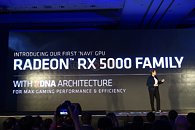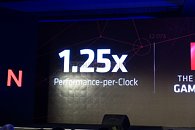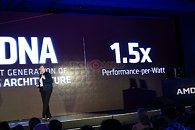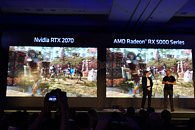Monday, May 27th 2019

AMD Announces Radeon RX 5700 Based on Navi: RDNA, 7nm, PCIe Gen4, GDDR6
AMD at its 2019 Computex keynote today unveiled the Radeon RX 5000 family of graphics cards that leverage its new Navi graphics architecture and 7 nm silicon fabrication process. Navi isn't just an incremental upgrade over Vega with a handful new technologies, but the biggest overhaul to AMD's GPU SIMD design since Graphics CoreNext, circa 2011. Called RDNA or Radeon DNA, the new compute unit by AMD is a clean-slate SIMD design with a 1.25X IPC uplift over Vega, an overhauled on-chip cache hierarchy, and a more streamlined graphics pipeline.
In addition, the architecture is designed to increase performance-per-Watt by 50 percent over Vega. The first part to leverage Navi is the Radeon RX 5700. AMD ran a side-by-side demo of the RX 5700 versus the GeForce RTX 2070 at Strange Brigade, where NVIDIA's $500 card was beaten. "Strange Brigade" is one game where AMD fares generally well as it is heavily optimized for asynchonous compute. Navi also ticks two big technology check-boxes, PCI-Express gen 4.0, and GDDR6 memory. AMD has planned a July availability for the RX 5700, and did not disclose pricing.
In addition, the architecture is designed to increase performance-per-Watt by 50 percent over Vega. The first part to leverage Navi is the Radeon RX 5700. AMD ran a side-by-side demo of the RX 5700 versus the GeForce RTX 2070 at Strange Brigade, where NVIDIA's $500 card was beaten. "Strange Brigade" is one game where AMD fares generally well as it is heavily optimized for asynchonous compute. Navi also ticks two big technology check-boxes, PCI-Express gen 4.0, and GDDR6 memory. AMD has planned a July availability for the RX 5700, and did not disclose pricing.





202 Comments on AMD Announces Radeon RX 5700 Based on Navi: RDNA, 7nm, PCIe Gen4, GDDR6
Not that I would expect less from someone who claimed cartels are OK, to justify nVidia.
Let me repeat it in big easy to read letters for you: ISA is there to stay, as 11 old CUDA, 7 years old GCN isn't going anywhere. As for microarchitecture, it is very apparently different even between Polaris and Vegas.
Equivalent GCN ISA docs: rocm-documentation.readthedocs.io/en/latest/GCN_ISA_Manuals/GCN-ISA-Manuals.html
There's not a whole lot different between Polaris and Vega other than the 16-bit instructions. It is unknown what Navi adds that Vega doesn't have. It might be less about ISA and more about optimization of the graphics pipeline.
There are IPC differences even between Vega 64 and VII.Arguing about semantics. The very link you've posted is titled "CuDA toolkit"In terms of instruction sense, what does Zen 2 add, what Zen doesn't have?
One coudl stick with the same ISA and yet have vastly different architectures on silicon level, what is there really to argue about?
PTX is not really an ISA either - it is middleware and a virtual machine is probably the best description for it. Nvidia does not have a static ISA as such over generations, they use PTX to expose the microarchitecure in a somewhat static way. AMD's GCN has been a fairly static thing regardless of the microarchitecture underneath.
PTX 1.0 = CUDA 1.0 = sm_{10,11}
www.techpowerup.com/forums/threads/nvidia-graphics-ip.244158/
G80 is the first GPU to use DirectX 10 (Shader Model 1.0)/CUDA 1.0 = GeForce 8800 series = first launched November 8, 2006 with 8800 GTX and GTS
PTX ISA is 12 years, 6 months, 27 days old.
And, cough.
AMD makes most of their ISAs available here:
developer.amd.com/resources/developer-guides-manuals/
Again, there are grey areas all around it but at a high level:
- From what we know AMD's GCN is a fairly by-the-book ISA on GCN cards. Not completely so but generally this is the case.
- Nvidia has been deliberately unclear about what their actual hardware ISA looks like for every generation. It is exposed almost exclusively via PTX that is effectively the ISA for Nvidia cards but not what the hardware itself does as PTX is a VM layer above hardware. I am sure there are drawbacks to this approach, more complex software/driver development being the obvious one.
That hold mostly true for CPUs as well. x86 has been done to death and beyond, but ever since the inclusion of the FPU onto the CPU, CPUs have advanced not by revolutionizing the x86 implementation*, but by implementing complementary instruction sets: x87, MMX, SSE, AVX in their various incarnations.
*doesn't mean the x86 implementation hasn't been refined in the meantime, just that it wasn't the only advancement vector anymore
And if they don't, how on earth does one know what micro-arch is used by AMD?
Both architecture/microarchitecture and ISA/implementation are hardware things. Above that are varying layers of APIs, usually in software, sometimes in firmware. The reason this whole thing was brought up was your claim that CUDA is Nvidia's ISA which is patently incorrect. CUDA is an API (and a specialized one at that), PTX is still an API but a lower level one and while Nvidia is not being too clear about it PTX seems to be brought to life to hide ISA changes between GPU generations. Nvidia has never been forthcoming about what the ISA for their GPUs really is.
GCN is architecture, ISA. Microarchitecture is its implementation.
Well, you can call PTX an ISA if you want. Nvidia halfway does. It is worth noting though that PTX is a virtual machine with a defined ISA (read: software). How this is mapped into actual GPU hardware is not well known (and Nvidia does not say). There is enough evidence to say the ISA underneath PTX is different between GPU generations. Nvidia drivers contain a compiler that compiles PTX code into binary code.